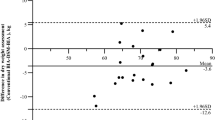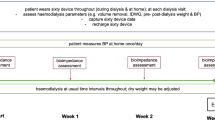Abstract
Background
Dry weight is the lowest weight patients on hemodialysis can tolerate; correct dry weight estimation is necessary to minimize morbi-mortality, but is difficult to achieve. Here, we used artificial intelligence to improve the accuracy of dry weight assessment in hemodialysis patients.
Methods/Results
We designed a neural network which used bio-impedancemetry, blood volume monitoring, and blood pressure values as inputs; output was artificial intelligence dry weight. Fourteen pediatric patients were switched from nephrologist to artificial intelligence dry weight. Artificial intelligence dry weight was higher (28.6%), lower (50%), or identical to nephrologist dry weight. Mean difference between artificial intelligence and nephrologist dry weights was 0.497 kg (− 1.33 to + 1.29 kg). In patients for whom artificial intelligence dry weight was lower than nephrologist dry weight, systolic blood pressure significantly decreased after dry weight decrease to artificial intelligence dry weight (77th to 60th percentile, p = 0.022); anti-hypertensive treatments were successfully decreased or discontinued in 28.7% of cases. In patients for whom artificial intelligence dry weight was higher than nephrologist dry weight, no hypertension was observed after dry weight increase to artificial intelligence dry weight; when present, symptoms of dry weight underestimation receded.
Conclusions
Neural network predictions outperformed those of experienced nephrologists in most cases, proving artificial intelligence is a powerful tool for predicting dry weight in hemodialysis patients.

Similar content being viewed by others
References
Neu AM, Frankenfield DL (2009) Clinical outcomes in pediatric hemodialysis patients in the USA: lessons from CMS’ ESRD CPM project. Pediatr Nephrol 24:1287–1295. https://doi.org/10.1007/s00467-008-0831-0
Chavers BM, Solid CA, Daniels FX, Chen SC, Collins AJ, Frankenfield DL, Herzog CA (2009) Hypertension in pediatric long-term hemodialysis patients in the United States. Clin J Am Soc Nephrol 4:1363–1369. https://doi.org/10.2215/CJN.01440209
Peng W, Li Z, Xu H, Xia C, Guo Y, Zhang J, Liu K, Li Y, Pu J, Zhang H, Cui T (2018) Assessment of right ventricular dysfunction in end-stage renal disease patients on maintenance haemodialysis by cardiac magnetic resonance imaging. Eur J Radiol 102:89–94. https://doi.org/10.1016/j.ejrad.2018.02.036
Fischbach M, Zaloszyc A, Shroff R (2015) The interdialytic weight gain: a simple marker of left ventricular hypertrophy in children on chronic haemodialysis. Pediatr Nephrol 30:859–863. https://doi.org/10.1007/s00467-015-3086-6
Gotta V, Marsenic O, Pfister M (2018) Age- and weight-based differences in haemodialysis prescription and delivery in children, adolescents and young adults. Nephrol Dial Transplant. https://doi.org/10.1093/ndt/gfy067
Raimann J, Liu L, Tyagi S, Levin NW, Kotanko P (2008) A fresh look at dry weight. Hemodial Int 12:395–405. https://doi.org/10.1111/j.1542-4758.2008.00302.x
Heerspink HJL, Ninomiya T, Zoungas S, de Zeeuw D, Grobbee DE, Jardine MJ, Gallagher M, Roberts MA, Cass A, Neal B, Perkovic V (2009) Effect of lowering blood pressure on cardiovascular events and mortality in patients on dialysis: a systematic review and meta-analysis of randomised controlled trials. Lancet 373:1009–1015. https://doi.org/10.1016/S0140-6736(09)60212-9
Sands JJ, Usvyat LA, Sullivan T, Segal JH, Zabetakis P, Kotanko P, Maddux FW, Diaz-Buxo JA (2014) Intradialytic hypotension: frequency, sources of variation and correlation with clinical outcome. Hemodial Int 18:415–422. https://doi.org/10.1111/hdi.12138
Paglialonga F, Consolo S, Edefonti A, Montini G (2018) Blood pressure management in children on dialysis. Pediatr Nephrol 33:239–250. https://doi.org/10.1007/s00467-017-3666-8
Allinovi M, Saleem MA, Burgess O, Armstrong C, Hayes W (2016) Finding covert fluid: methods for detecting volume overload in children on dialysis. Pediatr Nephrol 31:2327–2335. https://doi.org/10.1007/s00467-016-3431-4
Torterüe X, Dehoux L, Macher MA, Niel O, Kwon T, Deschênes G, Hogan J (2017) Fluid status evaluation by inferior vena cava diameter and bioimpedance spectroscopy in pediatric chronic hemodialysis. BMC Nephrol 18:373. https://doi.org/10.1186/s12882-017-0793-1
Wong Vega M, Srivaths PR (2017) Air displacement plethysmography versus bioelectrical impedance to determine body composition in pediatric hemodialysis patients. J Ren Nutr 27:439–444. https://doi.org/10.1053/j.jrn.2017.04.007
Srisuwan K, Hongsawong N, Lumpaopong A, Thirakhupt P, Chulamokha Y (2015) Blood volume monitoring to assess dry weight in pediatric chronic hemodialysis patients. J Med Assoc Thail 98:1089–1096
Nielsen MA (2015) Neural Networks. Neural Networks and Deep Learning, Determination Press
Gil Y, Greaves M, Hendler J, Hirsh H (2014) Artificial intelligence. Amplify scientific discovery with artificial intelligence. Science 346:171–172. https://doi.org/10.1126/science.1259439
Acknowledgments
The authors would like to thank the nurses at Robert Debré Pediatric Nephrology Department for their help in assessing dialysis parameters during this study.
Author information
Authors and Affiliations
Corresponding author
Ethics declarations
Conflict of interest
The authors declare that they have no conflict of interest.
Ethical approval
All procedures performed in studies involving human participants were in accordance with the ethical standards of the institutional and/or national research committee and with the 1964 Helsinki declaration and its later amendments or comparable ethical standards.
Informed consent
Informed consent was obtained from all individual participants included in the study.
Rights and permissions
About this article
Cite this article
Niel, O., Bastard, P., Boussard, C. et al. Artificial intelligence outperforms experienced nephrologists to assess dry weight in pediatric patients on chronic hemodialysis. Pediatr Nephrol 33, 1799–1803 (2018). https://doi.org/10.1007/s00467-018-4015-2
Received:
Revised:
Accepted:
Published:
Issue Date:
DOI: https://doi.org/10.1007/s00467-018-4015-2




